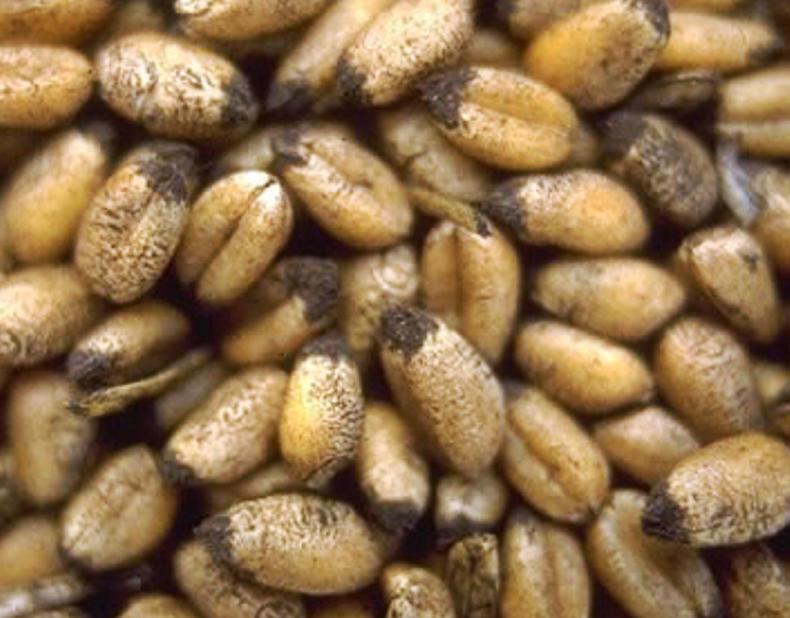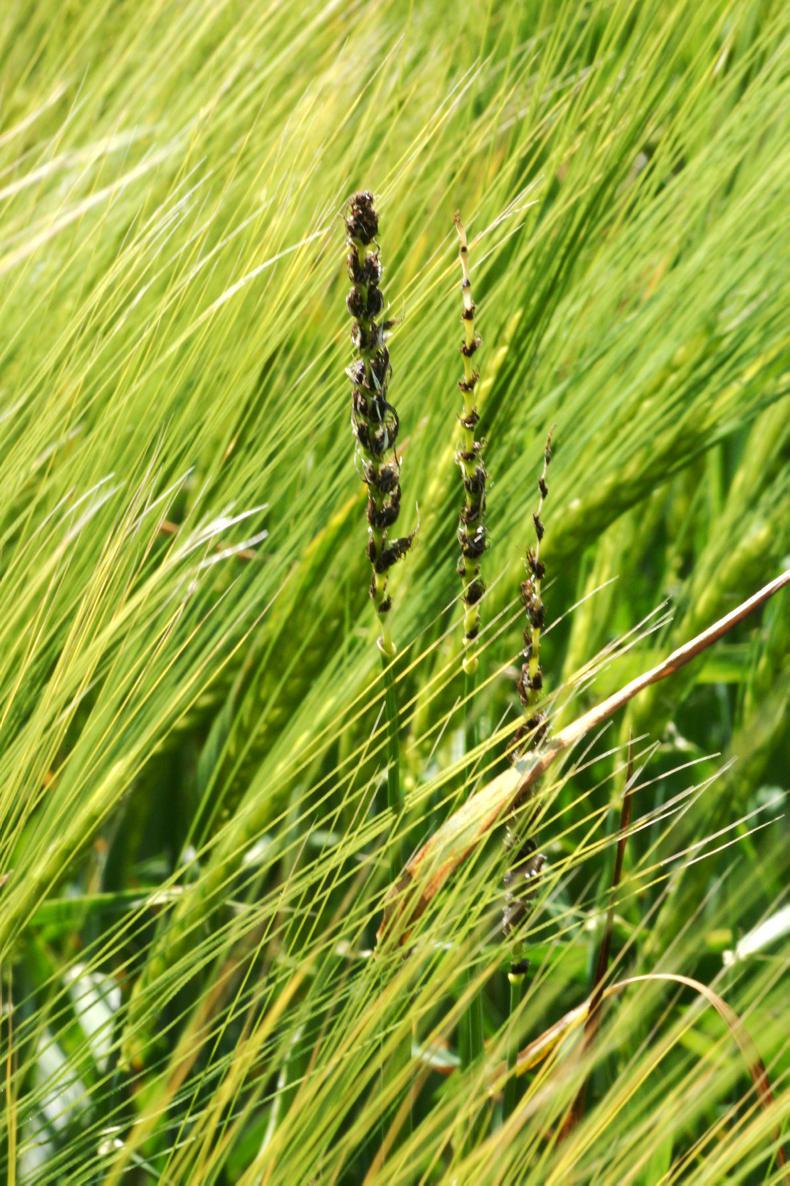There are many seedling diseases that impact on cereal crops in different ways. Some, like seedling blights, can reduce germination, while others can slow or decrease establishment. Some diseases like smuts attack the reproductive system and have little or no impact on the early season growth of the plant. Here is a brief description of some of the main seedling diseases.

With bunt some grains are taken over by the fungus which grows within the seed coat to form bunt balls. When these are broken during harvest the black spores can be seed all over other grains leaving them infected for the following season. The disease is also called covered smut because the smut spores remain enclosed in the seed coat until around harvest time.
This disease is potentially very dangerous and can destroy grain production if there’s a high enough infestation. It is caused by the fungus Tilletia tritici which grows in germinating seeds of wheat only and develops during formation of the grains post-flowering, where it replaces starch during grain fill, resulting in a sack full of teliospores. These spores either burst during harvesting to spill onto other seeds going through the combine, or they may fall intact onto the ground to cause subsequent soil infection.
Symptoms: There are no visible symptoms of this disease until after the ears emerge on the wheat plants. At that point, plants are often stunted and may have yellow streaks along the flag leaf. Infected ears are a dark grey-green colour with slightly gaping glumes.
As stated previously, bunt balls replace all grains on an infected plant and, if broken, release millions of black spores that produce a smell said to be closest to that of rotten fish. For this reason the disease is also often called stinking smut.
While the teliospores are normally only released during harvesting, in prolonged wet weather the spores may begin to ‘leak’ out in advance to run onto the head and down the ripe stem, making it look as though it has been covered in a black ink-like substance.
Thankfully this disease remains insignificant in these regions, but it can multiply rapidly from almost nothing if it is ignored.
Life cycle: Spores carried on the surface germinate with the seeds to invade the shoot and growing points. The fungus then grows within the plant and multiplies to produce spores in the grain sites after ear emergence. Affected plants appear normal until after the ear emerges, when it can be seen that grain sites have been replaced by bunt balls. As each bunt ball contains millions of spores, the capacity for contamination of healthy grain is enormous.
The majority of spores are released during harvest to contaminate healthy grain. Contamination can continue during seed movement, transport and storage. Spores can also be deposited onto the soil or blow in the wind to neighbouring fields. Soil-borne spores can subsequently invade seedlings very early in germination.

Loose smut infection is not seen in a crop until after earing out when the full head has been replaces by black spores. Infection levels can build up quickly in a seed stock. The fungal spores grow within the seed coat initially but this will have weakened by the time the ears emerge to allow the spores to spread.
This disease is much more common. It has a different life cycle to bunt, even though it also disrupts grain production in infected plants. It is crop specific, attacking all the main cereals with different selective organisms, and affecting each one:
Wheat - Ustilago nuda f.sp. tritici (U. tritici) Barley - Ustilago nuda f.sp.hordeiOats - Ustilago avenae Symptoms: With this disease the ear is generally completely replaced by black fungal spores at the grain sites. Occasionally an ear can be partly affected. The black spores are released just after the ear emerges from the sheath, leaving the rachis looking bare. All ears on the same plant are affected. The fact that the blackened ears are so obvious means that even a very low incidence of this disease is severe and sends out a definite warning.
While loose smut is potentially very serious, the combination of seed certification and improved variety resistance have minimised seed-borne infection and the use of effective seed dressing can remove infections when necessary.
Life cycle: For this disease the infection is within the seed and the fungus is present inside its embryo. As the seed germinates, so does the fungus grow and the mycelium, or fungal strands, grow within the plant to extend with it so the disease can infect the developing ear. Eventually the spikelets are replaced with masses of black fungal spores (teliospores) which are released when the ear emerges from the leaf sheath.
Spores are then spread by wind where they can enter in to the open flowers on near-by healthy plants. Where this happens the fungus then grows to infect the developing grain sites to leave the seeds infected. If this seed is replanted the fungus will grow and the process will cycle again if the infection is not controlled by an appropriate seed dressing.
Weather conditions during flowering affect the length of time that the florets remain open, and therefore the length of time that the plant is susceptible to infection. For this reason, the level of infection transfer can vary considerably between years.
There are many seedling diseases that impact on cereal crops in different ways. Some, like seedling blights, can reduce germination, while others can slow or decrease establishment. Some diseases like smuts attack the reproductive system and have little or no impact on the early season growth of the plant. Here is a brief description of some of the main seedling diseases.

With bunt some grains are taken over by the fungus which grows within the seed coat to form bunt balls. When these are broken during harvest the black spores can be seed all over other grains leaving them infected for the following season. The disease is also called covered smut because the smut spores remain enclosed in the seed coat until around harvest time.
This disease is potentially very dangerous and can destroy grain production if there’s a high enough infestation. It is caused by the fungus Tilletia tritici which grows in germinating seeds of wheat only and develops during formation of the grains post-flowering, where it replaces starch during grain fill, resulting in a sack full of teliospores. These spores either burst during harvesting to spill onto other seeds going through the combine, or they may fall intact onto the ground to cause subsequent soil infection.
Symptoms: There are no visible symptoms of this disease until after the ears emerge on the wheat plants. At that point, plants are often stunted and may have yellow streaks along the flag leaf. Infected ears are a dark grey-green colour with slightly gaping glumes.
As stated previously, bunt balls replace all grains on an infected plant and, if broken, release millions of black spores that produce a smell said to be closest to that of rotten fish. For this reason the disease is also often called stinking smut.
While the teliospores are normally only released during harvesting, in prolonged wet weather the spores may begin to ‘leak’ out in advance to run onto the head and down the ripe stem, making it look as though it has been covered in a black ink-like substance.
Thankfully this disease remains insignificant in these regions, but it can multiply rapidly from almost nothing if it is ignored.
Life cycle: Spores carried on the surface germinate with the seeds to invade the shoot and growing points. The fungus then grows within the plant and multiplies to produce spores in the grain sites after ear emergence. Affected plants appear normal until after the ear emerges, when it can be seen that grain sites have been replaced by bunt balls. As each bunt ball contains millions of spores, the capacity for contamination of healthy grain is enormous.
The majority of spores are released during harvest to contaminate healthy grain. Contamination can continue during seed movement, transport and storage. Spores can also be deposited onto the soil or blow in the wind to neighbouring fields. Soil-borne spores can subsequently invade seedlings very early in germination.

Loose smut infection is not seen in a crop until after earing out when the full head has been replaces by black spores. Infection levels can build up quickly in a seed stock. The fungal spores grow within the seed coat initially but this will have weakened by the time the ears emerge to allow the spores to spread.
This disease is much more common. It has a different life cycle to bunt, even though it also disrupts grain production in infected plants. It is crop specific, attacking all the main cereals with different selective organisms, and affecting each one:
Wheat - Ustilago nuda f.sp. tritici (U. tritici) Barley - Ustilago nuda f.sp.hordeiOats - Ustilago avenae Symptoms: With this disease the ear is generally completely replaced by black fungal spores at the grain sites. Occasionally an ear can be partly affected. The black spores are released just after the ear emerges from the sheath, leaving the rachis looking bare. All ears on the same plant are affected. The fact that the blackened ears are so obvious means that even a very low incidence of this disease is severe and sends out a definite warning.
While loose smut is potentially very serious, the combination of seed certification and improved variety resistance have minimised seed-borne infection and the use of effective seed dressing can remove infections when necessary.
Life cycle: For this disease the infection is within the seed and the fungus is present inside its embryo. As the seed germinates, so does the fungus grow and the mycelium, or fungal strands, grow within the plant to extend with it so the disease can infect the developing ear. Eventually the spikelets are replaced with masses of black fungal spores (teliospores) which are released when the ear emerges from the leaf sheath.
Spores are then spread by wind where they can enter in to the open flowers on near-by healthy plants. Where this happens the fungus then grows to infect the developing grain sites to leave the seeds infected. If this seed is replanted the fungus will grow and the process will cycle again if the infection is not controlled by an appropriate seed dressing.
Weather conditions during flowering affect the length of time that the florets remain open, and therefore the length of time that the plant is susceptible to infection. For this reason, the level of infection transfer can vary considerably between years.








 This is a subscriber-only article
This is a subscriber-only article











SHARING OPTIONS: